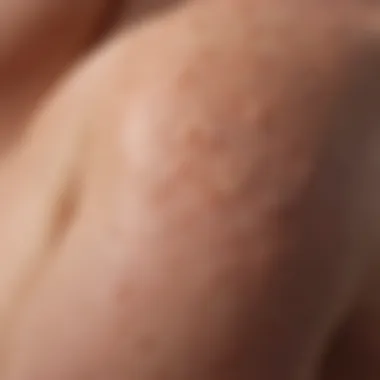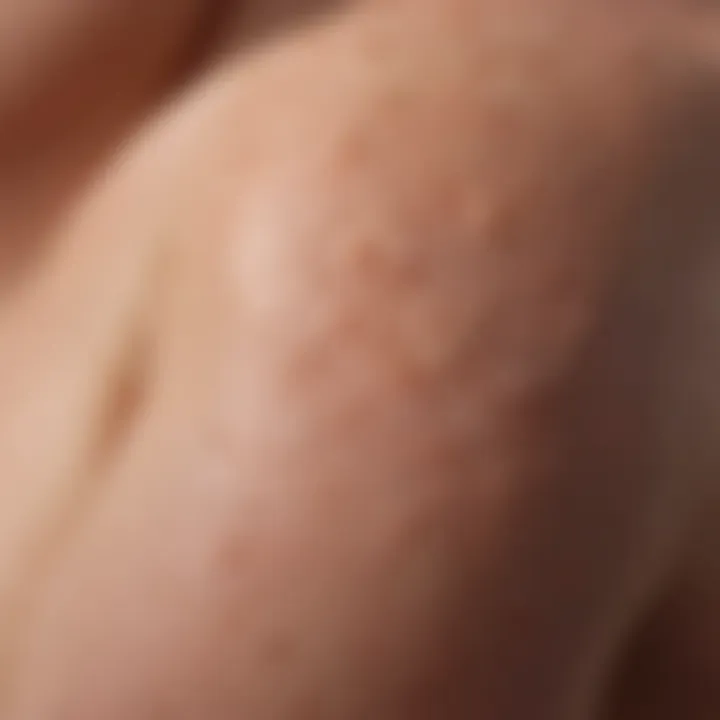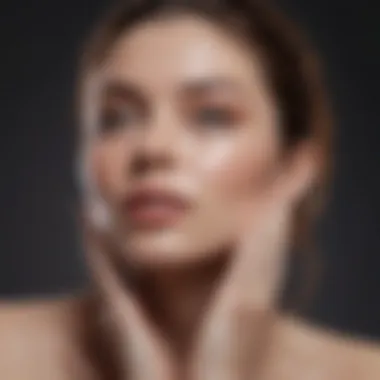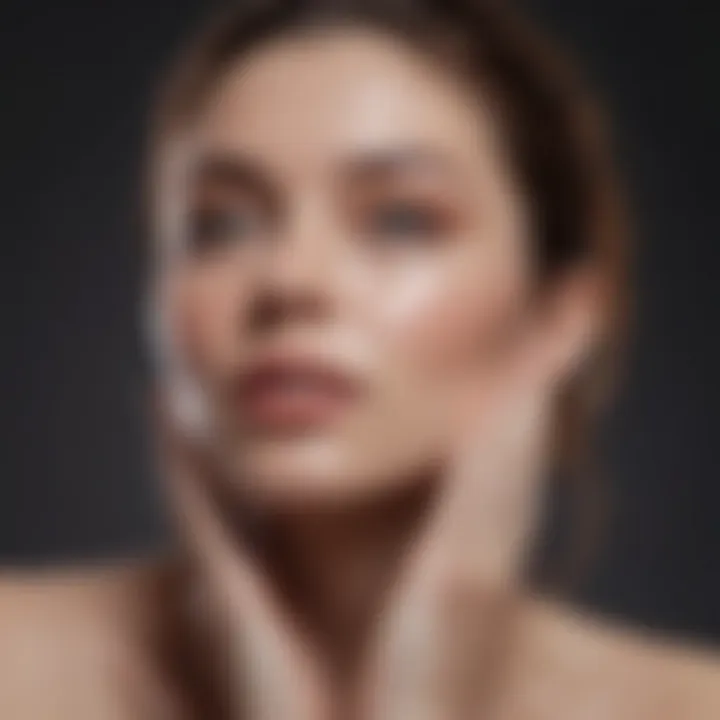Effective Strategies to Eliminate Hair Bumps


Intro
Hair bumps, often linked to ingrown hairs or folliculitis, are common concerns that can arise from various grooming practices. These conditions can be not just annoying but also uncomfortable. Understanding how to manage and prevent hair bumps effectively involves delving into their causes, which often relate to inappropriate hair removal techniques, skin sensitivity, and even environmental factors.
In this article, we will explore practical strategies that individuals can implement to avoid and treat hair bumps. Alongside remedies and solutions which cover everything from natural treatments to consider during skincare routines, we will offer insights into the underlying problems that cause hair bumps. With these tools, beauty enthusiasts and practitioners will be equipped to not only address current issues but to prevent them in the future, fostering a smoother and healthier appearance.
Causes of Hair Bumps
To effectively tackle hair bumps, it is important to understand what causes them. Common factors leading to this condition can include:
- Improper shaving techniques: Techniques including using dull razor blades or shaving dry skin can cause hair to grow back into the skin.
- Hair removal methods: Waxing or other hair removal techniques can sometimes irritate the skin and lead to in-growth.
- Tight clothing: Friction caused by tight clothing can affect hair follicles, leading to irritation and therefore bumps.
By realizing the triggers, one can take established preventive measures to ensure a reduction of these unpleasant bumps.
Prevention Strategies
Preventing hair bumps involves establishing a solid grooming routine and adopting habits that promote skin health. The following strategies can help:
- Exfoliate Regularly: Use a gentle exfoliating scrub to remove dead skin cells. This helps to open the pores and can prevent hair from growing back into the skin.
- Moisturize: Keeping the skin hydrated is crucial. Makeup routines or skin-drying environments can increase the chances of bumps.
- Use Quality Shaving Products: Invest in quality razors and shaving gels that suit your skin type. This can significantly reduce post-shave irritation.
Remember, remaining consistent in your routine can lead to notable improvements.
Treatments for Hair Bumps
If prevention fails, treatments can provide relief and assist in healing existing bumps. Consider the following methods:
- Warm Compress: Applying a warm compress helps reduce inflammation and can ease discomfort.
- Over-the-counter Treatments: Creams containing benzoyl peroxide, salicylic acid, or hydrocortisone can be useful in treating inflammation and breakouts.
- Consulting Professionals: In stubborn cases, seeking advice from dermatologists can provide tailored treatment options that address specific needs.
Understanding Hair Bumps
Understanding hair bumps is crucial for individuals facing this common skin issue. These bumps can affect self-esteem and overall appearance. Learning about hair bumps helps in proper management and prevention. It allows for effective treatments and enhances personal grooming practices. Recognizing their nature converts frustration into actionable solutions.
What are Hair Bumps?
Hair bumps, often called ingrown hairs, occur when hair grows back into the skin. This may lead to redness, discomfort, and sometimes infection. They can manifest as small, raised pimples or deeper lumps in certain cases. Understanding the definition of hair bumps is vital for anyone who experiences them. Unravelling their characteristics helps to clarify why attention to this topic is relevant.
Common Causes of Hair Bumps
Different factors can lead to the formation of hair bumps. Understanding these causes allows for better treatment and prevention methods. Problems such as ingrown hairs, folliculitis, razor burn, and blocked hair follicles are significant contributors.
Ingrown Hairs
Ingrown hairs are perhaps the most recognized cause of hair bumps. When a hair grows inward instead of outward, it creates an inflammatory response that presents itself as a bump. The key characteristic of ingrown hairs is their tendency to be found in areas with thick hair coverage, like the beard or bikini line. They are particularly popular in discussions related to hair bumps due to their prevalence. The upside of understanding ingrown hairs includes being able to identify entry points for prevention and correct treatment.
Folliculitis
Folliculitis refers to the inflammation of hair follicles, usually caused by infection. Bacteria or fungi can lead to this condition. The major highlighting aspect is how it may appear similar to acne. It can develop into pustules that occasionally itch. Recognizing folliculitis as a cause of hair bump issues helps in understanding how to address infections early. It can require targeted treatments, leading to advantages in both healing and preventing outbreaks.
Razor Burn
Razor burn occurs when hair is cut close to the skin level, leading to irritation and inflammation. Commonly experienced after shaving, its key feature is the resulting redness and sensitivity. Recognizing this condition is beneficial as it illuminates the challenges associated with shaving. Addressing razor burn properly could avoid the emergence of further bumps, averting the distress caused by them.
Blocked Hair Follicles
Blocked hair follicles happen when there are excess oils or dead skin. These clogs can trap hair and lead to bump formation. The main characteristic lies in its historical link with acne conditions. It is a prominent issue as it frequently occurs regardless of shaving practices. Understanding the underlying causes of blocked follicles aids in creating effective routines for preventing hair bumps.
Who is Prone to Hair Bumps?
Certain individuals are more predisposed to experience hair bumps. Those with thick or curly hair may often find themselves combating this concerning skin issue. While shavers and waxers may experience these bumps as a temporary condition, knowing which populations are at risk can aid in better care strategies. Factors include skin type, hair type, and specific grooming habits. Awareness among these populations suggests the necessity for tailored preventive approaches.


Prevention of Hair Bumps
Preventing hair bumps is a crucial part of maintaining smooth and healthy skin. Understanding the measures you can take to minimize the occurrence of this common problem not only enhances personal comfort but also jumps over potential skin irritation and infections. A proactive approach can contribute significantly to skin health, saving time and discomfort in the long run.
Proper Hair Removal Techniques
Shaving Methods
Shaving is a popular method for hair removal. It is crucial to use correct techniques. One technique is to shave in the direction of hair growth. This method decreases the chances of hair being cut at an angle, which could cause it to grow back into the skin. Proper use of a clean, sharp razor is vital because it reduces irritation on the skin. A good attribute about shaving is its convenience; it can be done at home and is quick.
That said, a disadvantage is the potential for razor burn and cuts, which can lead to hair bumps. Therefore, following up with an aftershave product is useful for soothing any minor irritations.
Waxing Considerations
Waxing is another technique a lot of people prefer for longer-lasting results. It pulls hair directly from the roots, which can result in finer hair regrowth over time. A key characteristic of waxing is the duration; results typically last longer than shaving. This technique can be beneficial for preventing hair bumps because hair is less likely to break off below the skin surface.
However, waxing can result in skin sensitivity and may cause uneven textures in some individuals after undergoing the procedure, particularly if they have sensitive skin.
Laser Hair Removal
Laser hair removal has gained popularity due to its effectiveness over time. This method uses concentrated light and is relatively painless compared to others. One specific advantage of laser treatments is its ability to target hair follicles specifically, decreasing hair regrowth. Consequently, the frequency of hair bumps can also greatly diminish as effectivity increases.
Nevertheless, it's essential to consult with a professional because multiple sessions may be necessary. It can be an expensive decision which not all users may prefer, making it less accessible for some individuals.
Skin Preparation and Aftercare
Exfoliation Practices
Exfoliation is an important practice for those dealing with hair bumps. Its main focus is to clear away dead skin cells that may be blocking hair follicles. Using gentle scrubs or chemical exfoliants can enhance skin smoothness and reduce the chance of ingrown hairs. Consider a balanced approach by exfoliating a couple of times per week based on your own skin type.
This is a beneficial practice since regular exfoliation can lead to skin vitality by brightening the complexion and preventing bumps. It is crucial to be careful not to over-exfoliate, as it can cause further irritation to the skin.
Moisturizing Recommendations
Moisturization is another key factor in preventing hair bumps. Dry skin can cause hair to become brittle and more likely to break during shaving or waxing. Applying a non-comedogenic moisturizer helps to nourish the skin while keeping elasticy and preventing blockage of pores. Look for gels or ointments that are suitable for sensitive skin.
Keeping the skin hydrated can be a popular routine among many people. It should not be skipped because moisturized skin recovers faster and offers a smoother surface for hair removal processes.
Choosing the Right Products
Shaving Creams and Gels
Using appropriate shaving creams and gels is central to a smooth shave. Using a gel or cream that provides effective lubrication can greatly reduce friction during shaving. One benefit of such products is reduced irritation, as they create a protective barrier against the razor. Gentle compositions are better, especially for sensitive areas to enhance performance.
However, some products may contain harsh chemicals that could exacerbate skin issues, so different formulations may be needed based on the skin's response to them.
Aftershave Products
Aftershave products can be a vital step following hair removal. The primary purpose of these products is to soothe the skin and reduce inflammation. They can help to maintain moisture, thus contributing to a barrier against potential bumps.
Moreover, a carefully chosen aftershave product can provide lasting benefits. Not all aftershaven creams deliver the same soothing effects, and those with alcohol can create irritation instead. Carefully selecting a product meant for your skin’s sensitivity is essential.
Starting to implement these understanding basics can transform the way you manage hair bumps and enhance your overall comfort and satisfaction.
By integrating appropriately vibrant strategies into your grooming routine, you can effectively minimize the presence of hair bumps.
Home Remedies for Hair Bumps
Home remedies are often the first line of defense against hair bumps, suuch as ingrown hairs or folliculitis. These remedies, often derived from natural ingredients, offer several benefits. They are generally more cost-effective compared to commercial treatments. Furthermore, many people find these methods to be less irritating to the skin, especially for those with sensitivity issues. In addition, utilizing home remedies can provide a sense of control over personal grooming routines.
Natural Exfoliants


Natural exfoliants play an essential role in treating hair bumps by removing dead skin cells and clearing clogged pores. Exfoliation also encourages healthy skin turnover.
Scrubs
Scrubs are physical exfoliants that manually remove dead skin cells using granules or particles. The main advantage of scrubs is their ability to immediately clear away dead cells. This means they caaan give visible results after just a few uses. They’re usually massaged into the skin in a circular motion, stimulating circulation and promoting smoother skin.
Despite their benefits, scrubs can sometimes cause irritation or micro-tears in the skin if used too aggressively. Therefore, people need to choose fine-textured scrubs that suit their skin sensitivity and may not apply them daily.
Chemical Exfoliants
Chemical exfoliants use active ingredients, such as alpha-hydroxy acids and beta-hydroxy acids to dissolve dead skin cells. They penetrte into the skin more deeply than scrubs. This leads to efficient unclogging of pores. They are valuable for regular use as they promote cell turnover without added friction.
The primary dilemma with chemical exfoliants is the potential for irritation, particularly for newer users. Starting with a lower concentration can help prevent adverse reactions. Overall, they provide a significant advantage in minimizing hair bumps effectively over time.
Soothing Treatments
After exfoliation, soothing the skin is necessary to ensure comfort. Sooting treatments help in reducing inflammation and calming irritation.
Tea Tree Oil
Tea tree oil is known for its anti-inflammatory and antimicrobial properties. It can help reduce redness and inflammation associated with hair bumps. Additionally, its antiseptic quality works against bacteria that can aggravate the condition. As a result, many people include tea tree oil in their skincare choices.
Care is needed when using tea tree oil. Dilution is essential to avoid skin reactions. It is best to carry out a patch test beforehand to ensure no allergies exist.
Aloe Vera Applications
Aloe vera is famous for its soothing and hydrating benefits. It helps skin recover quickly after irritation. Aloe is rich in vitamins and has anti-inflammatory properties that assist in alleviating bumps. This makes it a preferred alternative after shaving or epilation.
The unique advantage of aloe vera is its ability to hydrate and calm the skin simultaneously. However, those using aloe should inspect the specific product for additional preservatives that could irritate sensitive skin.
Hydration and Moisturization
Hydration is critical for skin health. Using Agood moisturizer that keeps skin barrier intact helps ou keep hair follicles clear from blockages. Employ moisturizers that have lightweight and non-comedogenic properties. They help achieve smooth and clear skin while allowing hair to grow out properly without bumps.
Based on these points, home remedies remain an integral part of treatment. Their availability, ease of use and complementing nature to clinical solutions readers a practical approach for those coping with hair bumps.
Medical Treatment Options
Medical treatment options play a crucial role in addressing hair bumps. While many individuals may successfully manage mild cases through home remedies, more persistent or severe hair bumps may require professional intervention. Understanding at what point to seek these medical treatments is important. These methods can provide numerous benefits, such as reducing inflammation, preventing infection, and ultimately promoting healing. Different treatment paths are available, from topical solutions to oral medications, allowing for tailored care based on individual needs.
Topical Treatments
Antibiotic Creams
Antibiotic creams are frequently recommended for dealing with skin infections that result from hair bumps. Their primary function is to fight bacteria that contribute to conditions like folliculitis and infection related to ingrown hairs. A key characteristic of antibiotic creams lies in their ability to not only combat bacteria but also help to reduce swelling and redness in affected areas. This makes them a beneficial choice for those experiencing severe symptoms.
One unique feature of antibiotic creams is their localized application, allowing targeted treatment that minimizes systemic side effects. However, it’s worth noting that these creams are often not a permanent solution. Continuous use can lead to diminished effectiveness and the potential development of antibiotic resistance, so consulting a healthcare provider about proper usage is essential.
Steroid Creams
Steroid creams are another option for individuals experiencing inflammation due to hair bumps. They help reduce swelling, redness, and irritation effectively. A key characteristic of these treatments is their anti-inflammatory properties, leading to noticeable relief from uncomfortable symptoms. This can be especially important for individuals suffering from painful outbreaks.
The advantage of steroid creams is their rapid effectiveness in soothing irritated skin. However, prolonged use can thin the skin and lead to other side effects, so it is recommended to use them under medical supervision and only when necessary.
Oral Medications
Antibiotics
Oral antibiotics may be necessary for persistent or recurrent hair bumps that do not respond to topical treatments. These medications work systematically to effectively eliminate internal infections caused by bacteria. A key characteristic of oral antibiotics is their broad-spectrum activity, which addresses multiple types of bacterial infection. Many will find them a beneficial option especially when localized treatments have been unsuccessful.


However, unique features of antibiotics include potential side effects, such as gastrointestinal discomfort and disruption of natural gut flora, emphasizing the importance of a doctor’s guidance when utilizing these medications.
Hormonal Treatments
For individuals whose hair bumps may be related to hormonal fluctuations, hormonal treatments can present a viable solution. Conditions like polycystic ovary syndrome, which can lead to increased skin sensitivity and hair growth irregularities, can contribute to recurring hair bumps. A key characteristic of hormonal treatments, including oral contraceptives, lies in their ability to regulate hormonal activity. This can result in a decrease in associated skin issues.
Proof of effectiveness comes from the stabilization of hormones, leading to fewer skin eruptions. However, using hormonal treatments may involve unique features such as side effects including mood changes and weight fluctuations. Discussing these options with a healthcare professional is essential for successful experiences.
Consulting a Dermatologist
Engaging a dermatologist brings the expertise necessary for treating stubborn hair bumps effectively. Dermatologists can design personalized treatment plans often involving a combination of topical treatments, oral medications, and lifestyle adjustments. Proper diagnosis is key. Hair bumps could be due to various causes. Having a specialist assess the conditions ensures that treatment approaches are appropriate. Engaging with a dermatologist is typically advisable when there's a high possibility of infection or persistent discomfort, ensuring that interventions are both effective and safe.
Lifestyle Adjustments
Lifestyle choices play a crucial role in the management and prevention of hair bumps. Understanding how various factors such as diet and stress levels affect skin health is essential for anyone experiencing this issue.
Dietary Considerations
A well-balanced diet contributes significantly to the health of your skin. What you consume can either combat or exacerbate inflammation-related conditions like hair bumps. Foods rich in vitamins A, C, and E can foster skin integrity, while omega-3 fatty acids possess anti-inflammatory properties, which may help to alleviate redness and irritation.
Some notable food options include:
- Fruits and Vegetables: Oranges, carrots, and spinach are excellent for skin repair and hydration.
- Fatty Fish: Mackerel, salmon, and sardines provide omega-3 and help reduce inflammation.
- Whole Grains: Quinoa, brown rice, and oats can maintain steady blood sugar levels, thereby ensuring minimal breakouts.
Reducing your intake of processed foods and sugars can also be beneficial in preventing irritation. Maintaining adequate hydration by drinking plenty of water is vital as well, as this helps flush out toxins that could lead to skin issues. Small changes in your diet might create a noticeable improvement in your skin's reaction after hair removal.
Stress Management Techniques
Furthermore, stress significantly impacts the skin's overall health. Increased stress levels have been plugged into exacerbating skin issues by triggering skin inflammation. Therefore, adopting stress management techniques is paramount. Clear approach may lead to better skin outcomes over time. Consider incorporating mindfulness practices into your daily routine. These could include practices such as:
- Meditation: Even a few minutes of meditation daily can help to provide emotional relief.
- Deep Breathing Exercises: Controlled breathing can trigger relaxation responses that ultimately could benefit skin inflammation.
- Gentle Exercise: Engaging in regular physical activity increases oxygen flow and can help calm your mind.
Finding what methods work best for you will involve some trial and experimentation. Incorporating a balanced diet and effective stress management practices promotes overall skin health and can defend against conditions like hair bumps. The modifications might not yield instant results, but over time, they may help in maintaining clearer skin and boosting your confidence.
When to Seek Professional Help
Understanding when to consult a professional for hair bumps is critical. Many individuals may try to manage the symptoms on their own and could benefit from professional insights or treatments. If the situation worsens after attempting at-home remedies, seeking professional help will prevent further discomfort and complications.
Signs of Infection
One key reason to consult a healthcare provider is the presence of signs that suggest an infection. Common indicators include:
- Increased redness and swelling around the affected area
- Pus-filled lesions or cysts that develop
- Persistent pain or tenderness that doesn't subside
If any of these symptoms appear, you should not ignore them. Infections can lead to more serious complications if left untreated, making it essential to seek assistance. The healthcare provider can prescribe the appropriate antibiotics or topical treatments to help address the issue effectively.
Remember, early intervention can save time and discomfort. Following the comfort of your home remedies, do not hesitate to consult with a specialist when symptoms such as these arise.
Persistent Hair Bumps
Another indicator that professional help is warranted is the persistence of hair bumps despite appropriate home treatments. If hair bumps linger for weeks or even months, it may signify underlying conditions like chronic folliculitis.
Consider these situations:
- No improvement with at-home remedies: If standard treatments like exfoliation, moisturizing, or over-the-counter creams fail, further investigation is needed.
- Recurrent outbreaks: When hair bumps keep returning, it raises the possibility of an issue that home care alone cannot address.
- Worsening Condition: If the bumps appear to worsen over time or develop additional symptoms, such as itching or a burning sensation, getting a professional evaluation is important.
Addressing persistent hair bumps can provide clarity on treatments. In certain cases, the dermatologist may suggest specialized care plans including topical or oral medications tailored to the individual’s specific skin and hair characteristics. Being proactive about persistent skin concerns ultimately leads to better management and fewer future complications.
Ending and Key Takeaways
Understanding how to effectively address hair bumps is essential for both aesthetics and skin health. Recognizing the various causes and appropriate treatments helps individuals to make informed choices. Key considerations include proper care techniques, remedies, and understanding when you may need expert advice.
Effective prevention and treatment of hair bumps depend largely on tailoring methods to one’s skin type and hair structure. For instance, individuals sensitive to shaving may find utilizing electric razors or considering laser hair removal beneficial, while others might prefer traditional methods with specific aftercare routines.
Key Takeaways:
- Awareness of Causes: Initiate before engaging in hair removal methods. Determine specific triggers for your hair bumps, which can inform suitable preventive measures.
- Prevention is Better than Care: Use and engage in regular exfoliation to maintain healthier skin.
- Choices Matter: Pay attention to the products you choose for hair removal. High-quality formulations can reduce irritation and risk.
- Consultation Recommended: Don't hesitate to seek professional advice when home care does not yield results. Persistent or painful bumps might indicate an underlying condition that needs medical attention.















